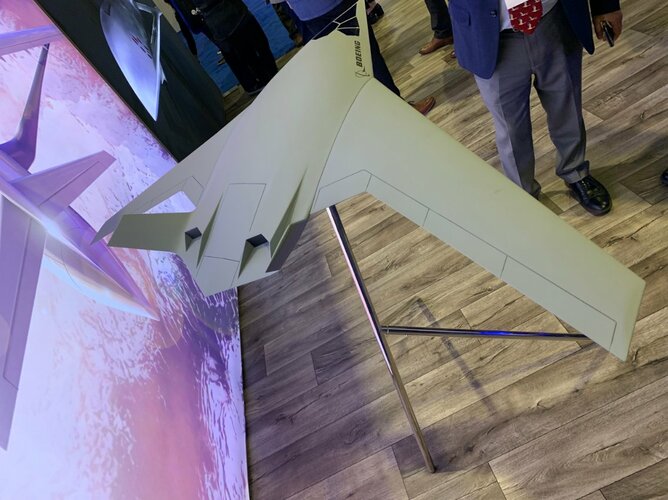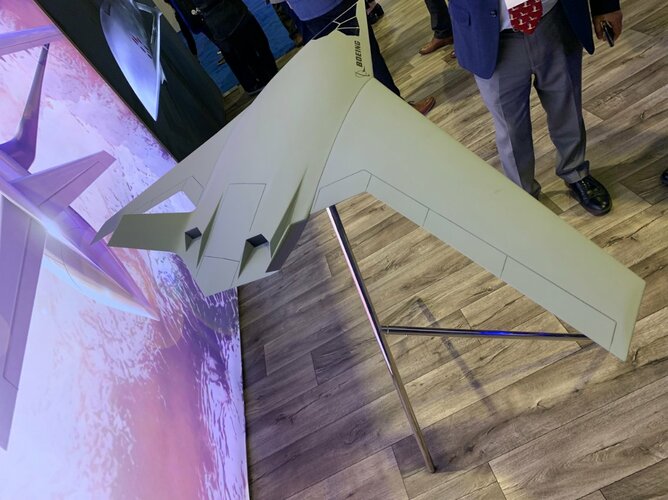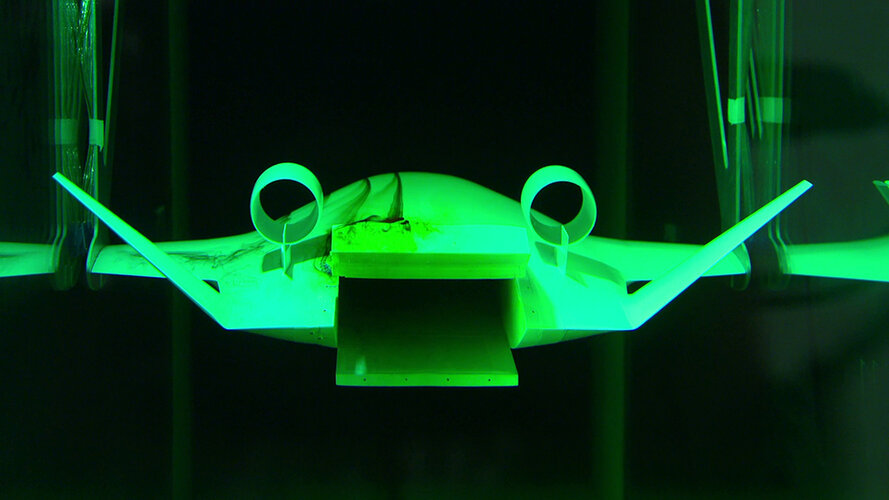You are using an out of date browser. It may not display this or other websites correctly.
You should upgrade or use an alternative browser.
You should upgrade or use an alternative browser.
McDonnell Douglas & Boeing BWB projects
- Thread starter flateric
- Start date
X-39
To post or not to post, that is the question
- Joined
- 20 February 2021
- Messages
- 382
- Reaction score
- 929
(PAYWALL)
 aviationweek.com
aviationweek.com
USAF Poised To Issue BWB Tanker-Transport Solicitation
July 01, 2022

Boeing displayed its BWB concept at the recent AIAA Aviation 2022 in Chicago. Credit: Guy Norris/AWST
CHICAGO—The U.S. Air Force is expected to issue a request for information (RFI) within the next week for the design of a large-scale prototype of a blended wing body (BWB), the first details of which emerged in President Biden’s recently announced fiscal 2023 budget request.
USAF Poised To Issue BWB Tanker-Transport Solicitation | Aviation Week Network
The U.S. Air Force is expected to issue a request for information (RFI) within the next week for the design of a large-scale prototype of a blended wing body, the first details of which emerged in President Biden’s recently announced fiscal 2023 budget request.
X-39
To post or not to post, that is the question
- Joined
- 20 February 2021
- Messages
- 382
- Reaction score
- 929
LOLOLOL. After 20ish years of preliminary studies they finally proceed to the RFI stage? I guess is better late than never. I think this also means we can say farewell to any hopes of KC-Z seeing the light of day.
X-39
To post or not to post, that is the question
- Joined
- 20 February 2021
- Messages
- 382
- Reaction score
- 929
Pentagon Seeks Blended Wing Body Concepts for Possible New Cargo, Tanker Aircraft
July 21, 2022 | By John A. Tirpak
The Pentagon has put out a call for blended wing body aircraft concepts that could be applied to future military tanker and cargo aircraft as well as commercial aircraft, according to a solicitation posted by the Defense Innovation Unit.
The Pentagon wants “concepts of design of an advanced aircraft configuration that provides at least 30 percent more aerodynamic efficiency than the Boeing 767 and Airbus A330 families of commercial and military aircraft, enabling operational advantages such as increased range, loiter time, and offload capabilities,” according to the solicitation.
The Boeing 767 and Airbus A330 are the bases for the KC-46 and KC-30 Multi-Role Tanker Transport, the only strategic tankers now in production.
An Air Force Research Laboratory spokesperson said the solicitation “is not connected to the KC-Y program” but did not say whether it’s related to the KC-Z, which the Air Force has not defined but could be a stealthy aerial refueling aircraft. The solicitation did not mention stealth or low observability, but BWB-type aircraft, as “flying wings,” would likely have a much lower radar cross section than traditional types.
Air Force Secretary Frank Kendall has in recent months cautioned the defense industry that analysis indicates that the KC-Y requirement—a follow-on to the 179-aircraft KC-46 program—seems to be best met by buying more KC-46s, with additional capabilities. Lockheed Martin has said it wants to offer its LMXT tanker, based on the Airbus KC-30 MRRT, for a KC-Y competition.
The blended wing body aircraft concept, because of its potentially large internal volume and aerodynamic efficiency, has been gaining interest from commercial airlines, cargo services, and the military for well over a decade. Boeing developed a BWB design for the X-48 program, which built and flew a subscale demonstrator in 2007 that received high marks. Lockheed Martin has also been promoting BWB concepts for tankers and cargo aircraft for a number of years.
“When integrated with projected 2030 engine technology, this advanced aircraft configuration is expected to provide at least 60 percent mission fuel burn reduction compared to current-day technology,” the DIU said.
It wants responses to the RFI by Aug. 2.
The RFI noted that the Defense Department consumes 77 percent of all the fuel used by the federal government, “and the majority of that is attributed to fuel for aircraft sorties supporting global operations.” The DIU said that “decades” of research into BWBs offer efficiencies that could sharply reduce fuel burn “and increase operational effectiveness, enabling longer-range sortie and reduced fuel logistics/supply chain risks.”
The solicitation is unusual in that its Air Force sponsor is not the Air Force Research Lab or the Life Cycle Management Center, but the Air Force Operational Energy Office. The DIU is also partnering with the Pentagon’s sustainability enterprise.
The Air Force has said that it is reviewing whether it will extend the service life of the C-17 Globemaster III or seek a new aircraft as its main strategic/tactical transport. It has ruled out a “stretched” model of the C-17 that would increase its internal load, as the service did with the C-141 Starlifter. The C-5M Galaxy underwent a major upgrade and re-engining in the last decade that is expected to keep that type operational into the 2040s.
The DIU said it wants interested companies to submit concepts showing how they will use digital tools and processes to “design, develop, test, verify, validate and certify the system for a possible follow-on prototype build, live-fly, and production.” These are to include engineering models in the Systems Modeling Language (SysML) “in a format that will serve as the Authoritative Source of Truth (ASot) for the entire design.”
It also wants the concepts to have modular, open-systems approaches for integration and upgrades.
Responses are to include the outer mold line and general arrangement of the aircraft; its performance and subsystems; what the risks are and how they can be bought down; a requirement analysis; a system engineering plan; a management plan; a life-cycle cost analysis; and plans for software design and ground and flight test plans. All of these are to come with a technology readiness level indicating their maturity.
Beyond the military applications, the DIU is looking for an analysis of how these aircraft could be applied to the civilian marketplace, with a marketing strategy, target customers, market potential, and the competitive advantages of such designs. The respondents are also to explain how they would manage intellectual property, create a management team, and provide an explanation of “how the commercialization plan would help reduce DOD procurement and life-cycle costs, and increase national security.”
The responses also need to include a manufacturing plan—along with an estimate of when production facilities could be ready to being manufacturing—as well as how these aircraft would connect to the joint all-domain command and control network.

Pentagon Seeks Blended Wing Body Concepts for Possible New Cargo, Tanker Aircraft | Air & Space Forces Magazine
The Pentagon has put out a call for blended wing body aircraft concepts that could be applied to future military tanker and cargo aircraft.
By August 2? That's a tight deadline!
Last edited by a moderator:
- Joined
- 28 January 2008
- Messages
- 1,024
- Reaction score
- 2,227
I think KC-Y is dead, don't think the USAF going to purchase a "interim" new tanker at this point, KC-46 seems to be on the road to recovery and in full-rate production, took long enough though. Attended ARSAG 2022 in April, a KC-Z still being considered, probably not going to be a full LO type and could be way out in the future. Blended wing-body (span loader) great for cargo and fuel capacity, has to be sized properly. LMCO and Boeing Speed Agile designs look promising and could be a good fit for the KC-Z requirement in my opinion.
- Joined
- 3 June 2011
- Messages
- 18,369
- Reaction score
- 12,325
"Let's make it so expensive that we can spend a lot of money figuring it out but not actually be able to afford to buy any."Pentagon Seeks Blended Wing Body Concepts for Possible New Cargo, Tanker Aircraft
Last edited by a moderator:
- Joined
- 4 July 2010
- Messages
- 2,516
- Reaction score
- 3,107
RFIs can have pretty short timetables, they're "just" trying to get an idea of where the industry is at on this general concept. RFPs are the ones that take awhile. USAF will probably have an industry day sometime next year if they're really getting serious.
Last edited by a moderator:
- Joined
- 28 January 2008
- Messages
- 1,024
- Reaction score
- 2,227
Designed and sized properly, it can transport and transfer all of the cost-overrun cash?"Let's make it so expensive that we can spend a lot of money figuring it out but not actually be able to afford to buy any."Pentagon Seeks Blended Wing Body Concepts for Possible New Cargo, Tanker Aircraft
- Joined
- 3 June 2011
- Messages
- 18,369
- Reaction score
- 12,325
I'd think both Lockheed and Boeing would have a lot to show given the years they'd been working on HWB and BWB respectively. (Unless they both threw in the towel there. Haven't heard from either of them on those in several years.)RFIs can have pretty short timetables, they're "just" trying to get an idea of where the industry is at on this general concept. RFPs are the ones that take awhile. USAF will probably have an industry day sometime next year if they're really getting serious.
- Joined
- 3 June 2011
- Messages
- 18,369
- Reaction score
- 12,325

Air Force Plans New Blended Wing Body Cargo/Tanker Aircraft by 2027 | Air & Space Forces Magazine
The Air Force plans to complete testing of a full-scale blended wing body cargo/tanker aircraft by 2027, according to a new climate plan.
- Joined
- 16 April 2008
- Messages
- 9,624
- Reaction score
- 14,563

Air Force Plans New Blended Wing Body Cargo/Tanker Aircraft by 2027 | Air & Space Forces Magazine
The Air Force plans to complete testing of a full-scale blended wing body cargo/tanker aircraft by 2027, according to a new climate plan.www.airandspaceforces.com
Full-scale!?!. Testing to be complete in 5 years? That means they pretty much have to start building within the next year. Feels like they must have the plans in their back pocket already.
- Joined
- 24 November 2008
- Messages
- 1,554
- Reaction score
- 2,627
Attachments
Nik
ACCESS: Top Secret
- Joined
- 15 July 2009
- Messages
- 1,272
- Reaction score
- 1,065
Snark:
Sadly, at this state of play, I would not trust Boeing to design and deliver a reliable toilet brush on-time and to budget...



/
FWIW, a dedicated tanker aircraft would seem an excellent fit for a BWB.
Unlike 'passenger' lay-outs, do not need multiple windows, exit hatches/slides etc etc.
Unlike 'cargo' layouts, do not need those complex design work-arounds for big hatches...
Okay, what am I missing ??
Sadly, at this state of play, I would not trust Boeing to design and deliver a reliable toilet brush on-time and to budget...
/
FWIW, a dedicated tanker aircraft would seem an excellent fit for a BWB.
Unlike 'passenger' lay-outs, do not need multiple windows, exit hatches/slides etc etc.
Unlike 'cargo' layouts, do not need those complex design work-arounds for big hatches...
Okay, what am I missing ??
- Joined
- 21 April 2009
- Messages
- 13,773
- Reaction score
- 7,751
Semi-stealthy arsenal ship loaded not only with hypersonic strike missiles, LRSO cruise missiles but a few dozen AIM-260sTanker and B-52 replacement would be perfect jobs for a BWB.
The T-7A project is going well with Boeing.
Prophet141
ACCESS: Confidential
- Joined
- 25 April 2022
- Messages
- 142
- Reaction score
- 121
What's the difference between a Hybrid Wing Body and a Blended Wing Body?I'd think both Lockheed and Boeing would have a lot to show given the years they'd been working on HWB and BWB respectively. (Unless they both threw in the towel there. Haven't heard from either of them on those in several years.)
- Joined
- 16 April 2008
- Messages
- 9,624
- Reaction score
- 14,563
What's the difference between a Hybrid Wing Body and a Blended Wing Body?
Hybrid has a tubular fuselage mated to a flying wing structure.
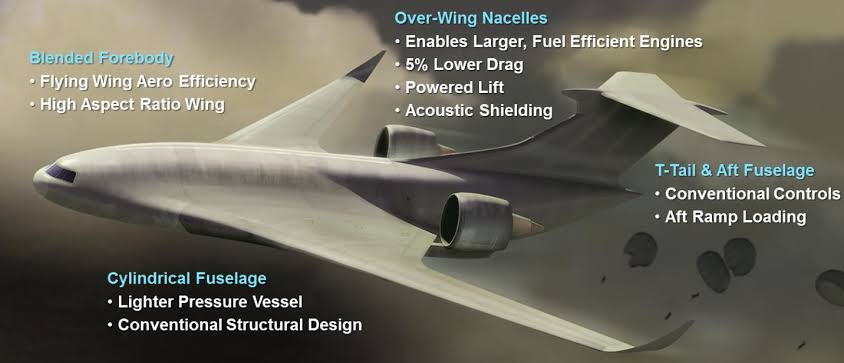
BWB has no cylindrical fuselage.
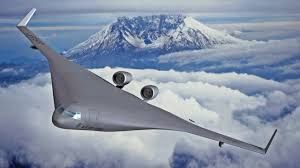
Both differ from a flying wing in that there is an element of traditional wing structure. All three do run together a bit, though.
Kat Tsun
eeeeeeeeeeeeeee
- Joined
- 16 June 2013
- Messages
- 1,381
- Reaction score
- 1,794
Snark:
Sadly, at this state of play, I would not trust Boeing to design and deliver a reliable toilet brush on-time and to budget...


/
FWIW, a dedicated tanker aircraft would seem an excellent fit for a BWB.
Unlike 'passenger' lay-outs, do not need multiple windows, exit hatches/slides etc etc.
Unlike 'cargo' layouts, do not need those complex design work-arounds for big hatches...
Okay, what am I missing ??
As punishment for CST-100, 787, and 767 MAX I propose Boeing lose a vowel, possibly "e".
We can then decide whether Boing will lose another vowel after the HWB saga.
- Joined
- 16 April 2008
- Messages
- 9,624
- Reaction score
- 14,563
Snark:
Sadly, at this state of play, I would not trust Boeing to design and deliver a reliable toilet brush on-time and to budget...


/
FWIW, a dedicated tanker aircraft would seem an excellent fit for a BWB.
Unlike 'passenger' lay-outs, do not need multiple windows, exit hatches/slides etc etc.
Unlike 'cargo' layouts, do not need those complex design work-arounds for big hatches...
Okay, what am I missing ??
The main issue I see is that even "dedicated" tankers usually end up carrying cargo too, especially on deployment flights where they both carry the squadron maintenance crew/equipment and refuel the squadron's planes. So, you need some access for container cargo at least, and some provision for passengers as well, even if they are seated on a cargo pallet.
Last edited:
Rhinocrates
ACCESS: Top Secret
- Joined
- 26 September 2006
- Messages
- 3,061
- Reaction score
- 7,815
The hybrid design or at least BWB with rear ramp integrates with existing cargo handling infrastructure, methods, & training. Lockheed's most recent hybrid design has a tail end similar to a C-17 while Boeing's 'purer' BWB concepts still have clamshell rear ramps. If two variants of the same airframe have to perform as tanker and freighter, it's easier to adapt a freighter to serve as a tanker than adapt a tanker to be a freighter - especially if it's adapted from an airliner itself. So it's not a work-around to fit a big hatch, the hatch is almost where the design starts.Unlike 'cargo' layouts, do not need those complex design work-arounds for big hatches...
Okay, what am I missing ??
Attachments
Last edited:
Scott Kenny
ACCESS: USAP
- Joined
- 15 May 2023
- Messages
- 11,737
- Reaction score
- 14,523
Airlines and mechanics all screamed when they saw how many engines (even if they only need 1 hour maintenance after each flight, there's still like 14 of them...) and where the engines were (OSHA working aloft regs...)I discovered this unusual variation on Boeing's well-worn blended wing body theme. It was studied under a NASA project called Cruise Efficient Short Take-Off and Landing (CESTOL) and these images come from a January 2006 presentation.
The objective was to design a low-noise aircraft that could operate from small regional airports to relieve congestion at major hubs. The aircraft uses distributed propulsion (lots of engines) to increase lift for STOL and to fill in the wake for reduced drag in the cruise. Mounting the engines above the wing/body provides noise shielding.
Been calling them "Boing" since 1998.As punishment for CST-100, 787, and 767 MAX I propose Boeing lose a vowel, possibly "e".
We can then decide whether Boing will lose another vowel after the HWB saga.
Rhinocrates
ACCESS: Top Secret
- Joined
- 26 September 2006
- Messages
- 3,061
- Reaction score
- 7,815
Quothe John Donne, 'Never send to know for whom the bell tolls; it tolls for thee.' Bong!
Kat Tsun
eeeeeeeeeeeeeee
- Joined
- 16 June 2013
- Messages
- 1,381
- Reaction score
- 1,794
Been calling them "Boing" since 1998.
The McDD pill goes hard. "Bong" since Starliner it is.
They can have the "i" back if they can pull off HWB. Otherwise they'll be sent to Poland with the rest of the consonants.
Similar threads
-
-
McDonnell Douglas Little Known Airliners
- Started by hesham
- Replies: 165
-
-
McDonnell Douglas & Boeing canard rotor wing (CRW) concepts
- Started by flateric
- Replies: 63
-
Secret Stealth VTOL Transport - "Senior Citizen"
- Started by flateric
- Replies: 263





